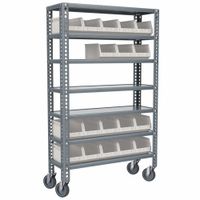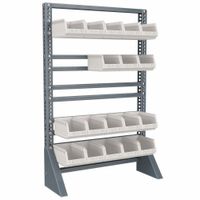Call +(254) 703 030 000 / 751 483 999 / 721 704 777
- Home
- Material Handling
- Storage Workspace
- Bin Compartmented Storage Units
- Bin Shelving Racks
.....Read More
Frequently Asked Questions
What are the benefits of using bin shelving and racks?
Bin shelving and racks offer several benefits for storage and organization:
1. **Space Optimization**: They maximize vertical and horizontal space, allowing for efficient use of available storage areas. This is particularly beneficial in warehouses and retail environments where space is at a premium.
2. **Improved Organization**: Bin shelving and racks help categorize and segregate items, making it easier to locate and retrieve products. This organization reduces time spent searching for items and enhances productivity.
3. **Enhanced Accessibility**: Items stored in bins and racks are more accessible, reducing the need for excessive bending or reaching. This ergonomic benefit can improve worker safety and efficiency.
4. **Scalability**: These systems are modular and can be easily expanded or reconfigured to accommodate changing inventory needs. This flexibility supports business growth and seasonal inventory fluctuations.
5. **Durability and Stability**: Made from robust materials like steel or heavy-duty plastic, bin shelving and racks are designed to withstand heavy loads and frequent use, ensuring long-term reliability.
6. **Inventory Management**: They facilitate better inventory control by providing clear visibility of stock levels, which aids in maintaining optimal inventory and reducing overstock or stockouts.
7. **Cost-Effectiveness**: By improving space utilization and inventory management, bin shelving and racks can reduce storage costs and improve operational efficiency, leading to cost savings.
8. **Safety and Cleanliness**: Properly organized storage reduces clutter, minimizing the risk of accidents and creating a safer work environment. It also helps maintain cleanliness and orderliness in storage areas.
9. **Versatility**: Suitable for various industries, including retail, manufacturing, and logistics, these systems can store a wide range of items, from small parts to large products.
10. **Aesthetic Appeal**: A well-organized storage area with bin shelving and racks can enhance the overall appearance of a facility, contributing to a professional and efficient image.
How do I choose the right size and type of bin shelving for my needs?
To choose the right size and type of bin shelving, first assess your storage needs by considering the items you plan to store. Measure the dimensions and weight of these items to determine the appropriate bin size and shelving capacity. Consider the volume of items to ensure you have enough bins and shelves to accommodate them.
Next, evaluate the available space where the shelving will be placed. Measure the height, width, and depth of the area to ensure the shelving fits comfortably without obstructing movement or access. Consider vertical space to maximize storage efficiency.
Select the type of bin shelving based on the environment and usage. For heavy-duty storage, choose metal or industrial-grade shelving. For lighter items, plastic or wire shelving may suffice. Consider adjustable shelving for flexibility in storing items of varying sizes.
Think about accessibility and organization. Opt for clear bins for easy visibility of contents or label bins for quick identification. Consider open shelving for frequently accessed items or closed shelving for dust-sensitive items.
Factor in durability and maintenance. Choose materials that withstand the conditions of your storage environment, such as moisture-resistant materials for damp areas. Ensure the shelving is easy to clean and maintain.
Finally, consider budget constraints. Compare prices of different shelving options and balance cost with quality and durability. Look for warranties or guarantees that offer protection against defects.
By carefully evaluating these factors, you can select the right size and type of bin shelving that meets your storage needs efficiently and effectively.
What materials are bin shelving and racks typically made from?
Bin shelving and racks are typically made from a variety of materials, each chosen for its specific properties to suit different storage needs:
1. **Steel**: Steel is the most common material used for bin shelving and racks due to its strength and durability. It can support heavy loads and is often coated with powder or galvanized to resist corrosion and rust. Steel shelving is ideal for industrial and warehouse settings.
2. **Aluminum**: Aluminum is lightweight yet strong, making it suitable for environments where mobility is important. It is also resistant to corrosion, which makes it a good choice for humid or wet environments.
3. **Plastic**: High-density polyethylene (HDPE) and polypropylene are popular plastics used for bin shelving. They are lightweight, resistant to chemicals, and easy to clean, making them ideal for food storage, medical facilities, and environments where hygiene is crucial.
4. **Wire**: Wire shelving is made from steel or chrome-plated steel wires. It offers good ventilation and visibility, which is beneficial for storing perishable goods or items that require air circulation. Wire shelving is commonly used in retail and food service industries.
5. **Wood**: Although less common in industrial settings, wood shelving can be used for lighter loads and offers a more aesthetic appeal. It is often used in retail or office environments where appearance is important.
6. **Composite Materials**: Some shelving systems use composite materials that combine the benefits of different materials, such as strength and lightweight properties. These are often used in specialized applications.
Each material offers distinct advantages, and the choice depends on factors like load capacity, environmental conditions, and specific industry requirements.
How do I install bin shelving and racks securely?
1. **Plan and Measure**: Determine the location and purpose of the shelving. Measure the space to ensure the shelving fits and allows for easy access.
2. **Select Shelving**: Choose shelving material (metal, wood, plastic) based on weight capacity and environment (e.g., metal for heavy loads, plastic for moisture-prone areas).
3. **Gather Tools and Materials**: You’ll need a drill, level, stud finder, screws, anchors, brackets, and a measuring tape.
4. **Locate Wall Studs**: Use a stud finder to locate studs in the wall. Mark their positions as they provide the strongest support for heavy loads.
5. **Mark and Drill Pilot Holes**: Mark where the brackets will be placed, ensuring they align with the studs. Drill pilot holes to prevent wood splitting.
6. **Install Brackets**: Secure the brackets to the wall using screws. If a stud is not available, use wall anchors to ensure stability.
7. **Attach Shelves**: Place the shelves onto the brackets. Secure them with screws if the design requires it.
8. **Level and Adjust**: Use a level to ensure the shelves are even. Adjust as necessary.
9. **Load Shelves**: Distribute weight evenly across the shelves. Place heavier items on lower shelves to maintain stability.
10. **Safety Check**: Double-check all screws and brackets for tightness. Ensure there is no wobbling or instability.
11. **Regular Maintenance**: Periodically check the shelves for any signs of wear or loosening and tighten screws as needed.
Can bin shelving and racks be customized or expanded?
Yes, bin shelving and racks can be customized and expanded to meet specific storage needs. Customization options include adjusting the size, material, and configuration of the shelving units to accommodate different types of items. Shelving can be made from materials like steel, plastic, or wood, and can be designed to hold varying weights and sizes of bins.
Expansion is possible through modular designs that allow additional shelves or racks to be added as storage needs grow. Many systems offer adjustable shelves, which can be repositioned to fit different bin sizes or to create more space between levels. Accessories such as dividers, label holders, and wheels can also be added to enhance functionality and organization.
For businesses, custom solutions can be tailored to fit specific industry requirements, such as anti-static materials for electronics or corrosion-resistant coatings for chemical storage. Customization can also include aesthetic choices, like color matching to brand themes or specific finishes to match existing decor.
Overall, the flexibility of bin shelving and racks makes them a versatile choice for both personal and professional storage solutions, allowing for efficient use of space and easy adaptation to changing needs.
What is the weight capacity of typical bin shelving and racks?
The weight capacity of typical bin shelving and racks can vary significantly based on the design, materials, and intended use. Generally, light-duty shelving units, often made of plastic or thin metal, can support weights ranging from 150 to 300 pounds per shelf. These are suitable for storing lighter items such as office supplies or small tools.
Medium-duty shelving, commonly constructed from heavier gauge steel or reinforced plastic, typically supports between 300 to 800 pounds per shelf. These are ideal for garages, workshops, or small warehouses where moderately heavy items like power tools or bulk supplies are stored.
Heavy-duty shelving and racks, often made from industrial-grade steel, can support significantly more weight, ranging from 1,000 to over 3,000 pounds per shelf. These are used in industrial settings, large warehouses, or distribution centers where heavy equipment, large quantities of inventory, or bulk materials are stored.
Pallet racks, a type of heavy-duty shelving, are designed to hold pallets of goods and can support several thousand pounds per level, depending on the configuration and materials used. The capacity of these racks is often determined by the beam and upright specifications, with some systems supporting up to 20,000 pounds or more per level.
It's important to note that the total weight capacity of a shelving unit or rack is not just determined by the individual shelf capacity but also by the overall structural integrity of the unit. Proper installation, load distribution, and adherence to manufacturer guidelines are crucial to ensure safety and maximize the weight capacity of shelving and racks.
How do I maintain and clean bin shelving and racks?
1. **Regular Inspection**: Check for damage, rust, or wear. Tighten loose bolts and replace damaged parts.
2. **Dusting**: Use a microfiber cloth or duster to remove dust from surfaces. For hard-to-reach areas, use a vacuum with a brush attachment.
3. **Cleaning**: Wipe down shelves with a damp cloth and mild detergent. Avoid harsh chemicals that can damage the finish.
4. **Rust Prevention**: For metal racks, apply a rust inhibitor or paint to prevent corrosion. Ensure the area is dry to avoid moisture buildup.
5. **Organizing**: Regularly reorganize items to prevent overloading and ensure even weight distribution. Label bins for easy identification.
6. **Safety Checks**: Ensure that heavy items are stored on lower shelves and lighter items on top to prevent tipping.
7. **Floor Maintenance**: Keep the area around the shelving clean and free of debris to prevent accidents and ensure easy access.
8. **Load Limits**: Adhere to the manufacturer's load capacity guidelines to prevent structural damage.
9. **Ventilation**: Ensure proper airflow around the shelving to prevent moisture buildup and mold growth.
10. **Training**: Educate staff on proper loading techniques and maintenance procedures to ensure longevity and safety.



